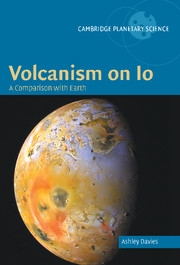Book contents
- Frontmatter
- Contents
- Preface
- List of Abbreviations
- Reproduction Permissions
- Introduction
- Section 1 Io, 1610 to 1995: Galileo to Galileo
- 1 Io, 1610–1979
- 2 Between Voyager and Galileo: 1979–1995
- 3 Galileo at Io
- Section 2 Planetary volcanism: evolution and composition
- Section 3 Observing and modeling volcanic activity
- Section 4 Galileo at Io: the volcanic bestiary
- Section 5 Volcanism on Io: the global view
- Section 6 Io after Galileo
- Appendix 1 Io hot-spot locations
- Appendix 2 Io maps
- References
- Index
- Plate Section
3 - Galileo at Io
Published online by Cambridge University Press: 05 October 2014
- Frontmatter
- Contents
- Preface
- List of Abbreviations
- Reproduction Permissions
- Introduction
- Section 1 Io, 1610 to 1995: Galileo to Galileo
- 1 Io, 1610–1979
- 2 Between Voyager and Galileo: 1979–1995
- 3 Galileo at Io
- Section 2 Planetary volcanism: evolution and composition
- Section 3 Observing and modeling volcanic activity
- Section 4 Galileo at Io: the volcanic bestiary
- Section 5 Volcanism on Io: the global view
- Section 6 Io after Galileo
- Appendix 1 Io hot-spot locations
- Appendix 2 Io maps
- References
- Index
- Plate Section
Summary
The Galileo mission was designed to be a detailed, in-depth investigation of Jupiter's atmosphere, the nature and evolution of its satellites and rings, and its magnetospheric environment. The Galileo spacecraft (Figure 3.1) and instrumentation were already under development by the end of the 1970s. Galileo consisted of an orbiter and an atmospheric probe that was destined to plunge into Jupiter's atmosphere. Galileo was a large spacecraft, weighing 2717 kg at launch. Of this mass, 925 kg was usable propellant, 339 kg was the atmospheric probe, and 118 kg was dedicated to orbiter science instruments. To maintain stability, the spacecraft rotated about its central axis at rates of up to 10 rpm. A “de-spun” section rotated at the same rate in the opposite direction in order to provide a stable platform for the imaging instruments. Four instruments (Table 3.1) – three imagers and an ultraviolet sensor – covering the electromagnetic spectrum from the extreme ultraviolet to the far infrared were mounted on a movable scan platform that allowed pointing of the instruments and the slews necessary to compensate for blur during fast satellite fly-bys. These instruments were bore-sighted to allow complementary imaging of a target by all of the imagers.
Galileo arrived at Jupiter on December 7, 1995. That it arrived at all was a triumph of human ingenuity over adversity, a decade of stubborn tenacity, and brilliant engineering solutions to some of the most intractable problems ever encountered with a spacecraft.
- Type
- Chapter
- Information
- Volcanism on IoA Comparison with Earth, pp. 39 - 50Publisher: Cambridge University PressPrint publication year: 2007

